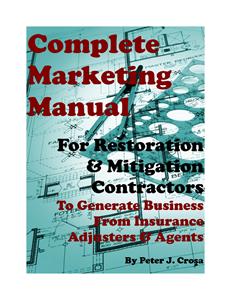Contractors and Adjusters - Finding Common Ground: The R&R Q&A

Chances are, if the adjuster and contractor aren’t working well together on a particular project, the customer isn’t going to be very pleased with the end result. Based on this alone, it’s important for adjusters and contractors to cooperate, communicate and work together to ensure that the project gets done well, the customer is satisfied and any other details are worked out accordingly.
To get a feel for how adjusters and contractors can accomplish this, we decided to take a direct approach – we asked* some of them. Here’s what they had to say:

From the Adjuster
To get an adjuster’s perspective, we asked Jake Price, a national general adjuster with J.F. Price & Co. LLC, a division of Reid, Jones, McRorie & Williams, Inc., and Michael Shepherd, a general adjuster with Shepherd Consulting.
Restoration & Remediation: What do you want the contractor to provide you on a loss?
Jake Price: Just be fair. If he is fair, everything will take care of itself.
Michael Shepherd: I would like a good diagram of the loss with both room size and ceiling height. On his diagram, I would like him to number all his points of moisture readings. In each room, I would like moisture readings with his calculations as to how much equipment is needed, both in terms of air movers and dehumidifiers.
R&R: If you weren’t on-site, what would you look for to get an accurate picture of what happened?
JP: I would look at anything available to get an accurate picture of the situation.
MS: As stated above, I want to have complete confidence that the information that I am given is complete, accurate and that each reading is showing the progress we are looking for. If not, I want to know steps are being taken to shorten the dry-out time.
R&R: What is your biggest challenge in closing claims in reference to the contractor?
JP: Most contractors, not all, want to stick it to the adjuster as much as possible. They demand high prices and it is always a struggle to get the contractor to accept what I believe is a fair price. To be straightforward, sometimes the adjuster, including me, has under-priced his estimate and we, as adjusters, need to accept the fact that costs are sometimes a lot higher than what some software program is telling us. The software program is a guide. A good estimate is a custom-priced document.
MS: I want to be sure that the dry-out is complete and that the insured is satisfied at each phase of the claim. I require that all my contractors get a signed Notification of Completion and Satisfaction (NOC&S) signed and dated by the insured. This is required of all contractors, not just the direct repair programs. If I have a repair contractor show up on one of my jobs where the dry-out is not complete, even if the insured has signed a NOC&S form, I don’t use that emergency service (ES) contractor again.
R&R: How can the restoration contractor assist you in overcoming said challenge?
JP: Be fair in scope of damage and pricing – that’s what it’s all about.
MS: Show up on the job timely. Don’t monitor the equipment at 6:30 p.m., upset the insured in the middle of their evening meal and then charge for two people to monitor the equipment at overtime rates. If you are an ES contractor, there should not be anything that is overtime. You manage your time and employees, and make the insured happy at all times. You may be the best contractor in the world, but adjusters don’t want complaints warranted or otherwise.
R&R: What would you like to tell all contractors before they start a claim in order to be able to be on common ground and have a smooth flow of the restoration of the insured to a pre-loss condition?
JP: I tell all contractors the same thing from day one: You be fair and I will be fair.
MS: Remember, the person you’re working for is the insured. You need to act like you’re getting your invoice paid by the insured. However, you should also make sure that you are verifying to me that what you’re charging for is clear, concise and verifiable.

From the Contractor
To get a contractor’s perspective, we asked Joe Pierron, of Online Insurance Claims Services and a Master Restorer with the IICRC, and Al Bradham, Owner of Carpet Care Services and DisasterCare.
R&R: What do you want the adjuster to provide you on a loss?
Joe Pierron: I would like the adjuster to confirm coverage, state any policy limits that may need to be addressed and inform me if he wants to be invoiced through fax, e-mail or another manner. I would also like to know up-front if he is expecting different coverage areas to be billed separately on one invoice or separate invoices. If there is reconstruction and my company provides that service, I would like him to tell me whether he will advise the insured to use us if comfortable with us, or if he will attempt to get another company or approved vendor to be used by the insured.
Al Bradham: A list of documentation needed to complete the claim. Every adjuster/insurance company wants documentation a different way or different type of documentation. Furthermore, some want no documentation and they get upset when you send it to them.
R&R: What do you think the adjuster expects if he doesn’t see any work you did on the job or have any communication with you?
JP: I try to put myself in the adjuster’s shoes when it comes to seeing an invoice. I think the adjuster would expect any unusual items to have attachments to line items with explanations, or explanation in opening and/or closing statements that denote any special circumstances on the particular loss. I would also include moisture readings, more pictures than I think he needs and the signed work authorization, direction of payment, certificate of completion and customer satisfaction survey.
AB: A very detailed and self-explanatory invoice. They should be able to read the invoice and understand exactly what you did, for how long, and why. If you used three air movers for five days then explain it that way.
R&R: What is your biggest challenge in the claims process in reference to the adjuster?
JP: My biggest challenge in communicating with the adjuster is to actually speak to him/her. A lot of phone tag goes on. These days with e-mail it is somewhat easier, but when there are minor line item issues, the best way to work them out is to discuss them verbally.
AB: Getting the adjuster to call you back. Most of the time, you are flying blind with no understanding of what the adjuster really wants or how they want it. But, usually, the adjuster is looking for professional results, a happy customer, a fair price and the job closed.
R&R: How can the adjuster assist you in overcoming said challenge?
JP: Simply put, answer the phone or return the call as soon as possible. Sometimes when I’m on the phone while driving, I miss my exit on the interstate. I highly value the adjuster’s time because I understand that many times their workload is tremendous and they struggle to close claims. Therefore, I try to keep the chit-chat to a minimum, even in e-mails, and get to the point quickly.
AB: Communication. If the adjuster had a type of check-off list that could be sent to us at the start of our restoration, we would know exactly what they want and/or need.
R&R: What would you like to tell all adjusters before you begin or as soon as possible in the mitigation process in order to be able to be on common ground and have a smooth flow of the restoration of the insured to a pre-loss condition?
JP: Whatever information I found, I would pass on to the adjuster. I would also like the adjuster to tell me what time frame to expect regarding payment, what names will be on the check and where it will be sent. In my first years of providing restoration services I found out the hard way that if you don’t check on the receipt and acceptance of your invoice, it may just sit on someone’s desk with a red flag on it. No one will do anything about it unless one minor issue was resolved that there was a question on. So, I would like the adjuster to let me know what the procedure is if there are any issues with our invoice.
AB: To do a little research on the company that they are dealing with. I am not the bad guy. In dealing with adjusters with whom we have worked previously, there are usually no problems. However, dealing with an adjuster for the first loss, they can misunderstand or assume beforehand who we really are and our level of professionalism. Regardless of who we are, until we prove otherwise, treat us as the good guy trying to make their customer happy.
*All questions were asked based on a Category 1 water loss.
Looking for a reprint of this article?
From high-res PDFs to custom plaques, order your copy today!







